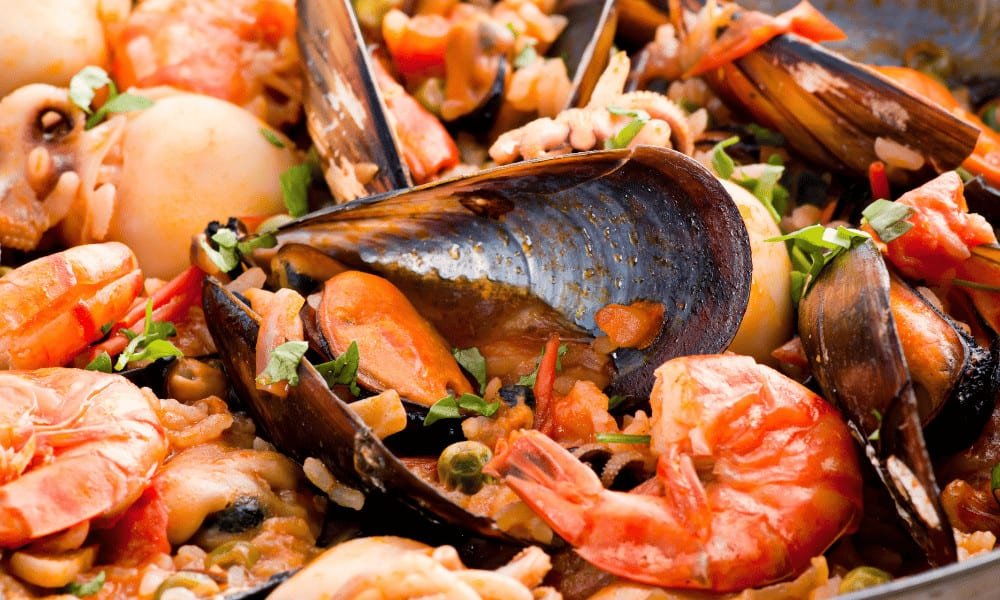Nothing screams Spain like a paella. It is filling, full of flavour and… It takes ages to perfect. So is there a way to batch cook it and have it stored at home for future meals?
Can You Freeze Paella?
Yes, you can freeze paella for up to 2 months. To freeze paella, as soon as it has cooled down, portion it into Tupperware containers with tight-fitting lids, seal the containers and place them in the freezer.
Do Does Paella freeze well? Yes
Can you refreeze Paella? No
How To Freeze Paella
So, as mentioned, before you get to freezing paella, you will want to let it cool. It just needs to cool down to room temperature. We would recommend spreading it out thin on a baking tray or plate to speed up the cooling down process.
The moment it is cooled to room temperature is when you need to get on with freezing it, which fortunately is very easy:
- Portion Into Containers: Grab a plastic container or Tupperware and spoon in your paella. Consider the portion sizes you will use and find a container that matches this size. This will avoid wastage further down the line.
- Seal: Place the lid on the container. If it is not tight-fitting, then you can wrap the container in a layer of clingfilm or foil to prevent any air from getting into the container.
- Freeze: Label the container with the contents and then finally, put your container in the freezer.
Vegetarian paella freezes well. Unlike meat or seafood paella, most vegetables will freeze really well, so you don’t need to worry too much about the ingredients in your paella.
How to Freeze Seafood Paella
Although the same method as above can be used for freezing seafood paella, there are a couple of things you will need to consider:
Source of Seafood: Where has your seafood come from, and can you be certain that it was not previously frozen? You won’t want to freeze your seafood repeatedly, especially if it has been cooked previously.
So consider the source of your seafood and only freeze it if you can be certain of how it was previously stored.
Seafood Shells: Freezing your seafood with attached shells is not advisable. If your paella has been adorned with mussels or clams in its shells, then you will want to remove those shells before freezing.
If you still want to serve your paella with a fancy garnish of seafood in their shells, then we would recommend cooking those elements fresh.
The above approach will work for most paella, but there are a few extra steps you need to take when freezing seafood paella, especially if it contains clams or mussels.
- Prep Seafood: First, you need to prep all of the seafood in your paella. This involves removing any shells and other inedible parts of any seafood in your dish. Once done so, you need to allow your paella to cool to room temperature.
- Portion: As soon as it has cooled, spoon your paella into a container with a tight-fitting lid.
- Seal and Freeze: Secure the lid before wrapping the container in a layer of clingfilm. Then place it in the freezer.
Yes, paella can be frozen with prawns but you’ll find that the prawns overcook when you reheat it. Instead, you’re better to freeze a plain paella and then add the prawns in afterwards. 
3 Tips for Freezing Paella
Now you know how to freeze it, we’ve got our 3 top tips which we strongly recommend following when freezing paella to have the best results:
Add Shellfish After Freezing
Shellfish such as clams do not freeze well, unfortunately. Instead of freezing paella with shellfish, try to freeze it without then adding the shellfish freshly cooked.
Act Fast
You’re aware of the dangers of leaving rice at room temperature. The moment it cooled down, act fast and get the paella in the freezer.
Freeze Into Portions
You cannot refreeze and then reheat paella again and again, so make sure you use suitable portion sizes containers.
How Long Can You Freeze Paella?
Unfortunately, paella won’t last long when stored in the freezer. Instead, we would limit the time it is frozen to 2 months. Various ingredients make it hard to control what does and doesn’t freeze well.
As with most frozen dishes, the longer you leave it in the freezer, the more the flavour and texture degrade.
Paella will keep in the fridge for around 3 days when kept in an airtight container with a tight-fitting lid. Once cooled, pop it straight into the freezer and do not leave it at room temperature.
How Do You Defrost Paella?
To defrost your paella, you will want to go with the slow and steady approach in the fridge, overnight. This will prevent bacteria from forming on the rice, which is common when rice is left at room temperature for too long.
Once the paella has defrosted, stirring a tablespoon of olive oil through the rice will help loosen it up.
You can then either reheat it in a pot until it is hot through or it can even be reheated in the microwave.
Can You Refreeze Paella?
As we’ve discussed in this article, this is a hard question to answer because it depends hugely on the ingredients in your paella and whether they were frozen previously.
Generally speaking, the most you want to freeze something is twice and usually, you only want to freeze things in a raw state once and then a cooked state once.
With paella containing rice, we would avoid refreezing paella – that’s why correctly freezing it in portions is a good idea.
Does Paella Freeze Well?
Initially, you’ll find that paella will freeze well.
Unfortunately, it won’t last this way long. If you compare a freshly made paella with a frozen paella, the difference will be hugely noticeable.
Having said that, if the options are freezing it or throwing it away, go with freezing it.
Related FAQs
If you’ve still got questions about freezing paella or paella in general, then these may help:
It can be perfectly safe. But it does come down to following the rules above and correctly cooling, storing and freezing the rice. We are all aware of the dangers of rice that are left at room temperature, and this is when it can become dangerous. We would highly advise following the advice from the NHS on this.
You can freeze paella with chorizo in it. The chorizo can be treated like any other meat you may have in the paella, such as chicken or, if you’re lucky, rabbit.


